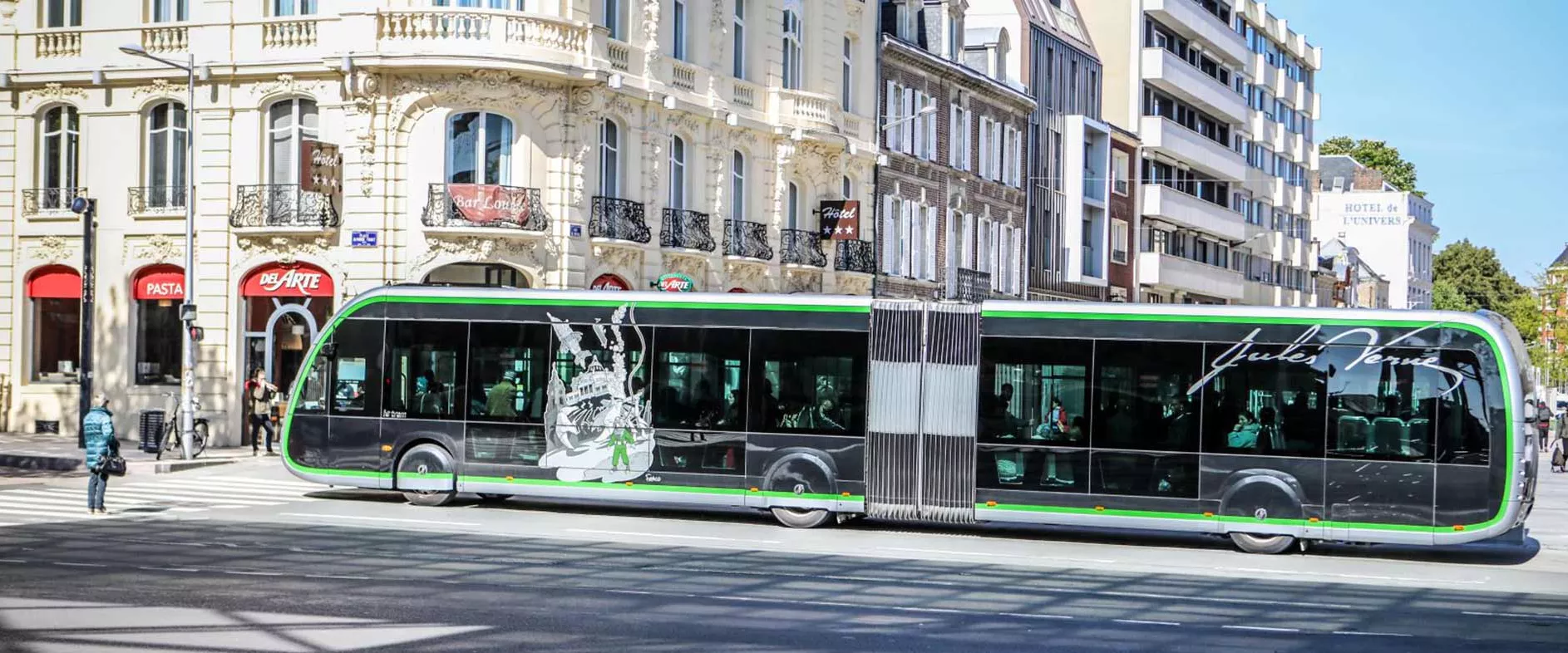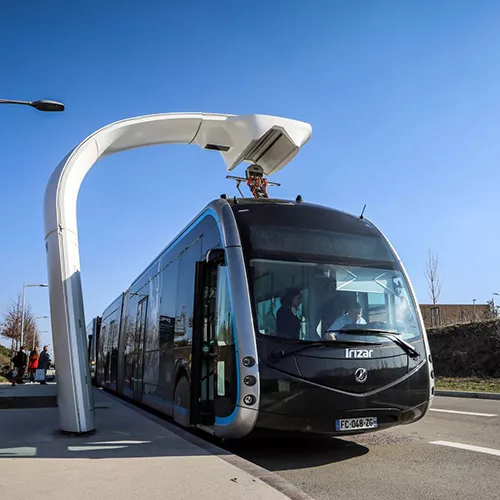
Reinventing bus service in Amiens, Metz, Pau and beyond
With its distinctive “light rail” look, bus rapid transit (BRT) is reinventing public transport in a growing number of cities keen to adopt a modern, attractive mobility solution that complements other modes of transport.
Since 2019, “Fébus”, the world’s first all-hydrogen-powered BRT system, has been operating in Pau, a city in southwestern France, with technical support from Keolis. Earlier that same year, Keolis also launched the all-electric BRT service in the nearby Bayonne-Anglet-Biarritz metropolitan area, and Europe’s largest network of electric buses in the northern French city of Amiens. With its dedicated lanes, innovative propulsion, extended hours, and distinctive “light rail on wheels” look, BRT is an increasingly attractive solution for metropolitan areas seeking high-performance, sustainable public transport.

BRT has prompted a
25%
increase in public transport ridership in Metz

1 km of BRT lane costs between €5 and
€8 million
compared with €20 million for light rail track

Amiens has
43 buses
and the largest e-bus network in Europe
Keolis at the forefront
As Group Executive Director France at Keolis, Frédéric Baverez witnessed firsthand the transformation of public transport from the inside. Looking back, he spoke with us about the growing success of these next-generation bus lines.
Why is BRT so popular?
Densely developed areas in cities with 200,000-250,000 residents need transport solutions that people want to use—and for that, the two key metrics are commercial speed and frequency of service. Bus rapid transit offers both and is more affordable than light rail. Building a light rail system costs about €20 million per kilometre, and light rail trainsets are priced at €2-3 million each. But with a BRT network, you’ll pay only €5-8 million per kilometre and €400,000-800,000 per vehicle—far less expensive.
Keolis in charge of the bus network in Metz until 2036
On October 6, 2025, the transport authority for the city of Metz awarded Keolis a 10-year contract to operate the LE MET’ network, starting on January 1, 2026. This contract worth over €700 million covers the bus network comprising 93 routes, including two BRT lines, and nearly 500 stations, serving all towns in the metropolitan area and providing more than 77,000 trips per day.
A total of €80 million will be invested in the transformation of rolling stock. By 2035, 60% of the network's vehicles are expected to be ultra-low emission: 34 hydrogen-powered buses will be gradually introduced between 2026 and 2027, and the 24-meter BRT buses will eventually be replaced by 100% electric, fast-charging ones.
What about very big cities?
Even for very big cities that already have infrastructure-intensive public transport systems, BRT offers a solution to the challenges of urban mobility. Because it’s more flexible, bus rapid transit can fill the gaps in an existing network, especially in outlying areas with less coverage. That’s true for Lyon, Lille, and Rennes.
But light rail can carry more passengers, right?
A BRT line can transport up to 35,000-40,000 passengers a day. It’s true that each bus carries fewer people than a light rail trainset, but if you look at overall passenger numbers, a BRT line has nearly the same capacity as a light rail line.
So BRT and light rail can complement each other?
It’s a mistake to see this as an either-or proposition. Each mode is useful in its own way—and besides, economics isn’t the only critical factor! Sometimes BRT is the best solution because of the way an urban area is laid out. In France, for example, there are many historic city centres with winding streets and right-angle turns, where it would be impossible to run 30m-42m light rail trainsets.

In what way is BRT different from a standard bus service?
The first big difference is infrastructure: BRT buses use dedicated lanes that are closed to private vehicles. They also have priority at traffic lights, and can run straight through the centre of a roundabout like light rail. That gives them a commercial speed of around 20 km/h, which is high. Secondly, BRT passengers don’t have to wait more than 10-12 minutes between buses at rush hour, and at the peak of rush hour that can drop to less than five minutes. Finally, this high frequency is combined with extended hours, starting in the early morning, around 5.30, and often continuing into the evening.
They also look very different...
That’s another essential point: BRT buses need to stand out—it’s part of their image. That’s one aspect of the strategy. And we put a lot of work into station design for the same reason. BRT buses can’t look like a run-of-the-mill articulated bus. Travellers have to see the difference in a single glance. From that standpoint, the BRT buses in Metz—which have three sections and are 24 meters long—are very successful.
BRT is also a lower-carbon option, isn’t it?
The public transport industry has a big responsibility to meet the challenges of the energy transition. At Keolis, we help transport organizing authorities choose and deploy vehicles that are more eco-friendly and emit less greenhouse gas. BRT buses are a highly suitable alternative to diesel.
Can you give us an example?
In Amiens, the new Nemo buses are 100% electric. With 43 buses, each 18 metres long, Amiens Métropole has the biggest 100% electric fleet in Europe. Tram Bus, an 100%-electric BRT service with 10 vehicles, has also been launched in the Bayonne-Anglet-Biarritz metropolitan area, in south-western France. The nearby city of Pau chose hydrogen propulsion for its Fébus fleet of 18-metre-long buses, which started operating end-2019—becoming the world’s first hydrogen-powered BRT network with buses that size. And the Sophia-Antipolis conurbation in south-eastern France has a natural gas-powered BRT system.
A new six-year term for Keolis in Amiens
Amiens Métropole has awarded Keolis a new six-year contract to operate and manage the Ametis transport network.
Since 2019, Keolis has supported the transformation and modernization of the Ametis network to deliver sustainable, innovative, and ever more efficient mobility for the 180,000 residents of the greater city community and its visitors.
As part of this new €245 million contract, we will offer a wide range of transport services, including the four Nemo BRT lines, 14 local lines adapted to the specific needs of municipalities, 13 school bus lines, and eight on-demand transport lines (ODT). Altogether, 39 municipalities will benefit from nearly 790 stops across the city region.
Over the next six years, Amiens Métropole aims 17.3 million annual trips on the Ametis network.
Does BRT help boost use of public transport?
Whenever new BRT lines appear, we see a sharp rise in ridership—and not just on the affected lines, but throughout the system, due to a ripple effect. BRT simultaneously delivers better service and projects a modern image. Take Metz as an example: a year after the launch of its new BRT service, public transport ridership had increased by 24.9%. And the numbers for other cities are about the same.
Compared with other countries, how does France rank in terms of BRT systems?
France is ahead of the curve on public transport, particularly when you look at per capita urban transport spending in cities with fewer than 1 million residents. And three of the world’s five largest BRT operators are French.
So is France a benchmark in BRT?
We’re exporting our expertise. If you look at alternative power sources, Sweden—which began eliminating diesel very early—is on the cutting edge. But when you compare countries that are about the same size, France is moving to electric fleets faster than Germany, England and Spain. And the shift is set to accelerate.
Share the article